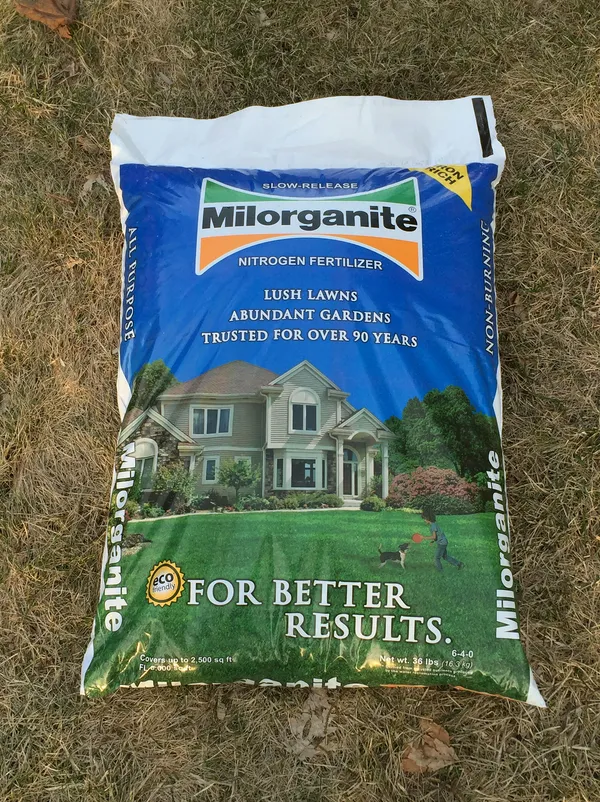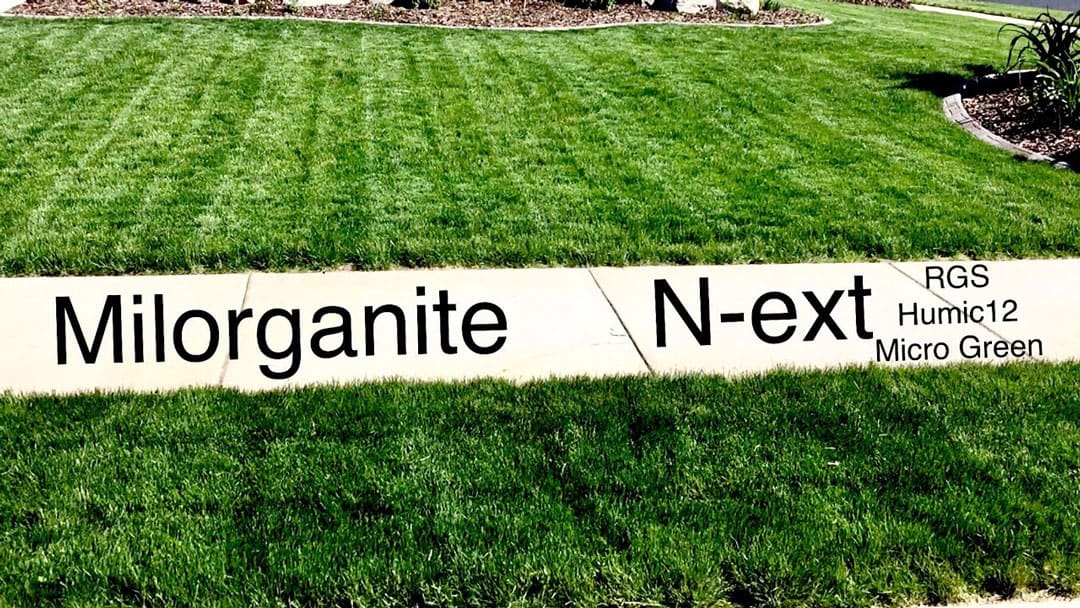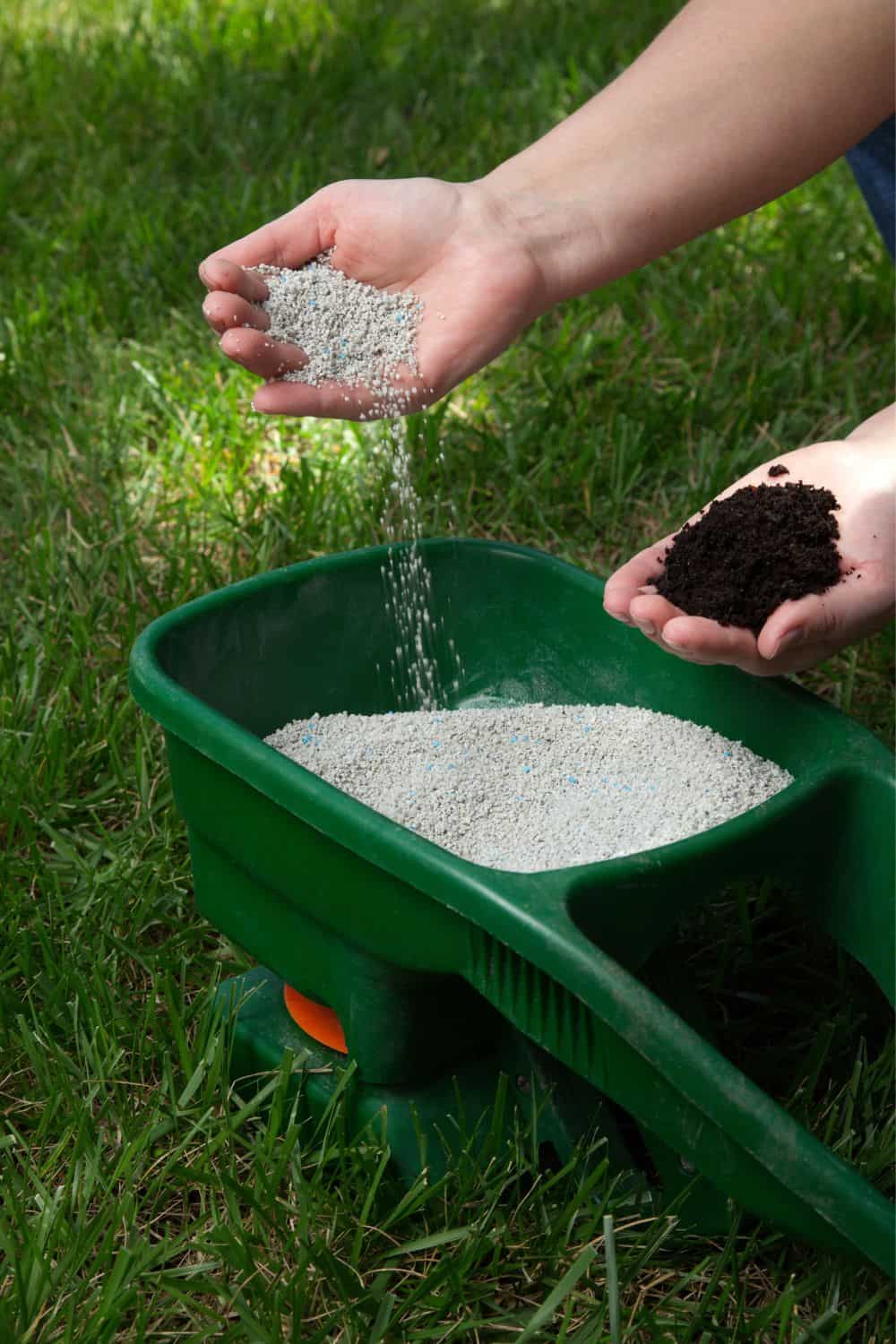Your lawn is your pride. Whether you have a postage stamp patch of grass in front of your home or acres of green hills in your backyard, you love your lawn. You spend your precious weekends tending it, mowing it to perfection, and enjoying the look of envy on the neighbors’ faces. You know your lawn needs food, just like your dog does.
A long time ago you have decided to be good to your lawn and the environment and chose Milorganite as your food of choice. The question is: when to apply Milorganite for the best effect and to avoid unnecessary expense. Let’s get into that in more detail, while learning about the difference between Milorganite and chemical fertilizers.
Milorganite vs. chemical fertilizers

Image Credit: milorganite
The question of timing and frequency of applying lawn fertilizer is less critical with Milorganite than with chemical fertilizer, but it is still very important.
Let’s look at the Milorganite, its composition and its way of affecting your lawn, and why it is so good for your lawn and the soil.
Fertilizers are produced from many different sources. Chemical or synthetically sourced fertilizers are produced from various minerals, gasses, and waste materials from inorganic sources. Organic fertilizers are made from natural sources such as organic waste and similar materials. Milorganite is an organic fertilizer.
Organic fertilizers
Organic fertilizers or Fertilizers derived from organic sources provide nutrients to the plants and benefits to the soil by improving its quality by stimulating useful soil microorganisms and improving the soil structure. Soil microbes play a major role in transforming organic fertilizers into the nutrients plants can use when they need them.
Organic fertilizers also provide the micronutrients and secondary nutrients plants need. Chemical fertilizers normally do not contain them. When used as instructed, organic fertilizers do not burn the plants’ roots.
Organic fertilizers normally have a lower NPK ratio (nitrogen, phosphorus, potassium) than synthetics fertilizers, but their effects last longer and their impact on the lawn is more subtle but longer-lasting.
Synthetic Fertilizer
Synthetic fertilizers are popular because they are fast-acting, are water-soluble, and can be used by plants right away. While this offers plants a quick nutrients hit and fast greening, the color does not last as long as when plants were fed with organic fertilizers. For that reason, chemical fertilizers have to be applied more often.
Synthetic fertilizers do nothing to improve the quality of the soil. Also, because they are so water-soluble, they can leach into our waterways. Their quick effect also means that they can burn the plants’ roots if applied in too strong doses.
What is Milorganite?

Image Credit: jsonline
Milorganite is an organic fertilizer made from wastewater by the Milwaukee Metropolitan Sewerage District (MMSD). The process, which is about 80 years old, is one of the oldest American recycling efforts, but instead of metal or plastic, nutrients are recycled from the municipal wastewater from the Milwaukee metropolitan area.
Wastewater is first cleared of all solid materials such as plastic, sand, cardboard, rags, plastic, and debris. Microbes are then added to the water where they digest the nutrients dissolved in the water.
After consuming all the nutrients, the microbes die. With the help of binding agents, the microbes are clump together and collected from the bottom of the sedimentation tanks. The cleaned water is then returned to Lake Michigan.
The microbes are dried at a high temperature and Milorganite is created. The N-P-K analysis for Milorganite is 6-4-0: 6 percent nitrogen; 4 percent phosphorus; and, 0 percent (less than one percent) potassium.
As an organic fertilizer, Milorganite is slow-release and feeds the lawn for up to10 weeks. It is mistake-proof, and you will not burn your lawn even if you over-fertilize, fertilize too often, or too much. It will be available to the lawn only when the grass needs it.
When to apply Milorganite to your lawn

Image Credit: purevege
The manufacturer’s recommendation is to apply Milorganite every 8-10 weeks at the beginning of the growing season. The schedule depends on your location and climate and what kind of grass you planted: northern (cool) season grass or southern (warm) season grass.
Northern, Cool-Season Grasses
Fertilize your Northern Grasses such as Fescue, Kentucky bluegrass, and Perennial Ryegrass with Milorganite four times a year.
In spring, fertilize your grass after the last possible frost, after your lawn starts to grow and turns green. The daytime temperatures should be in the 60s and the soil temperatures in the mid-50s. Use this convenient online tool to find out your soil temperature. Do not fertilize too early or your grass will have a spurt of growth instead of root development. Your lawn needs deep roots to survive the summer drought.
The last application in the season should be as late as possible, before the first frost or snow. This last fertilizing, called “dormant feeding,” encourages a greener, healthier spring lawn.
Southern, Warm-Season Grasses
Southern Grasses like St. Augustine, Bermuda, Centipedegrass, Zoysia, and Bahia should also be fertilized four times a year. Bahia and Centipedegrass grasses should be fertilized in spring and summer but not in the fall, to avoid winterkill.
You should fertilize your grass with Milorganite In spring, after the last possible frost, after your lawn starts to grow and turn green. Wait until the daytime temperature is in the 70s and the soil temperature in the 60s.
Try not to fertilize southern grasses late in the fall when the grass is starting to go dormant. Fertilizing at that time will encourage it to grow. It might make your grass less hardy entering the cold season.
The last time you should fertilize warm-season grasses is one month before it starts going dormant, before the first possible frost.
You do not need to water your lawn before or after fertilizing with Milorganite. This is one of Milorganite’s great advantages over chemical fertilizer. Milorganite is not water-soluble and it will stay inactive in the soil until temperature and water conditions are right for the microbes in the soil to start working. They break down the Milorganite nutrients and make them available for plants. While not necessary, watering the lawn after fertilizing with Milorganite will put the fertilizer in contact with the soil, speeding up the fertilization.
New Lawns
Before starting the new lawn, mix the top couple of inches of soil with Milorganite before seeding or sodding. Let the grass grow and apply two 32-lb bags to 2,500 sq ft of the lawn after you mow your lawn the third time. After that, use the usual recommended fertilizing plan for your kind of grass.
Is fertilizing your lawn necessary?

There is an ongoing debate about the damage the fertilizers are doing to the environment and or water tables. Having large lawns ais considered environmentally unfriendly and damaging.
Research conducted at the University of Minnesota shows that properly-maintained, regularly fertilized lawns are in fact better for the environment than lawns that are not fertilized.
The reason is that the fertilizer creates healthy root system that is better at preventing soil erosion and keeping soil in place than lawns with poor, unfertilized root systems. Unfertilized lawns have poor soil density, causing erosion and phosphorus runoff.
Another study conducted by the University of Wisconsin–Madison, found out that fertilizing with an organic fertilizer such as Milorganate causes less runoff of nitrogen and phosphorus in the runoff water from Kentucky bluegrass. In addition, even lawns fertilized with chemical fertilizer had less chemical runoff than lawns not fertilized at all.
The secret of a perfect lawn
Your lawn does not need much: plenty of sun, water, air, food, and mowing. You can control water – water thoroughly and infrequently; you can control the sun by cutting overhead branches that shade your grass. You can control air by regular de-thatching and aerating your lawn. You can control nutrients by providing the right kind of food, at the right schedule.
Nutrients
Plants need six main nutrients. Carbon, oxygen, and hydrogen the plants get from the air and water. Nitrogen, potassium, and phosphorus come mostly from fertilizer.
The best way to give your lawn the essential nutrients is by regular fertilization. Fertilize your lawn with Milorganite four times a year at the rates recommended by the manufacturer. Milorganite® as the organic fertilizer should be the primary source of nutrients for your lawn. This care strategy is not only good for your lawn but also for the environment.
Even the best soil eventually gets depleted of the nutrients your lawn needs and they have to be replenished. Feed your lawn regularly and it will reward you with the lush, dense growth and vivid green color.
Mowing
Mowing your lawn regularly is one of the vital requirements for having a healthy, green lawn. There is a debate among lawn enthusiasts: how long should your grass be?
Experts say: taller grass will keep your lawn in better health and weed-free.
The rule of thumb is: cut off only one-third of each blade of grass any time you mow. If you cut off more, you’ll start getting more weeds – weed seeds will start to germinate. If you cut your grass too short, you will also have to water it more often.
Conclusion
If you love your lawn and are environmentally conscious, you are probably already using Milorganite as your lawn fertilizer of choice. There are few very clear advantages of this fertilizer over all others:
- It is organic and it not only feeds the grass but improves the quality of soil;
- It is released slowly, becoming available to the grass when needed;
- It cannot burn the grass;
- It helps develop a good root system, helping the grass survive hot summer months;
Whatever your type of grass and climate, Milorganite should be applied four times a year. Some warm-weather grasses, such as Bahia and Centipedegrass, should not be fertilized in the fall, to avoid winterkill.
Now that the question of when to apply Milorganite has been answered, enjoy your lovely green lawn and get ready for the summer parties.

Leave a comment